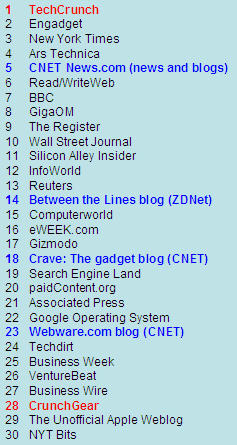Reality check: CNET and TechCrunch

Pardon the interruption in our regular programming for some inside techland. Henry Blodget is suggesting that CNET could acquire my friend Mike Arrington's TechCrunch sites for $100 million on the heels of analyst Douglas McIntyre's post explaining why he thinks TechCrunch and other blog operations will eventually be acquired for serious money by big media.
McIntyre is right in theory, and Blodget is wrong, or simply pumping up his traffic with poor research. First, I agree that TechCrunch, GigaOm, PaidContent and other upstarts will eventually be able to cash out by continuing to produce quality journalism, attract high quality audiences and generate some profit. And I personally (not speaking officially for the publicly traded CNET Networks) think it would be great if we could join forces, but Blodget's $100 million valuation is a bit steep, don't you think? McIntyre's analysis is also faulty. He states:
According to internet measurement service, TechCrunch has an audience about a third of CNet (CNET). And CNet is in bad shape. It's blog business has not caught on.
I would assume he is using Alexa for the numbers, which show TechCrunch with a third the daily page views of CNET.com and more than ZDNet. The numbers for ZDNet, which is part of CNET Networks, compared to TechCrunch are off by around a factor of ten. CNET.com probably does more page views in a single morning than TechCrunch does in a month. In terms of audience size, CNET.com has millions of unique users per day, compared to perhaps 1 million unique users per month (Feedburner cites 575,000 RSS subscribers) for TechCrunch.
CNET Networks (which includes sites such as CNET, GameSpot, TV.com, MP3.com, CHOW, ZDNet, and TechRepublic, with a global footprint) overall has more than 137 million unique users per month. According to official CNET Networks statements, 2007 total annual revenues are expected to be in the range of $405 million to $430 million. Including $20 million in stock compensation expense, operating income is estimated to be between $18 million and $33 million.
TechCrunch is a great site, a leader in its field and is nicely profitable on less than $10 million from advertising and event sponsorships.
McIntyre said that CNET's blog business has not caught on. Well, just the ZDNet blogs I manage have doubled in the traffic and unique users year over year. Comparing ZDNet blogs to TechCrunch is a little bit apples and oranges in that ZDNet is more focused on enterprise-related technology and has more individual blogs than TechCrunch.
In reality, TechCrunch competes directly with our CNET Webware and Crave, which have been growing strongly since they were launched less than a year ago. And, CNET News.com now has nearly 40 blogs, and CNET.com has 36 blogs.
The new Techmeme Leaderboard ranks sites every 20 minutes based on the amount of headline space they occupied on Techmeme over the 30 days. It's focused mostly on the Web 2.0 world, where TechCrunch has established itself covering startups and trends. As you can see from the rankings (from mid-day Oct. 1) CNET Networks blogs and news site have a strong presence, including this blog.
I have great admiration for Mike and team, and we enjoy working the same streets together. The Wall Street types should do more research than looking at Alexa to make their case.
